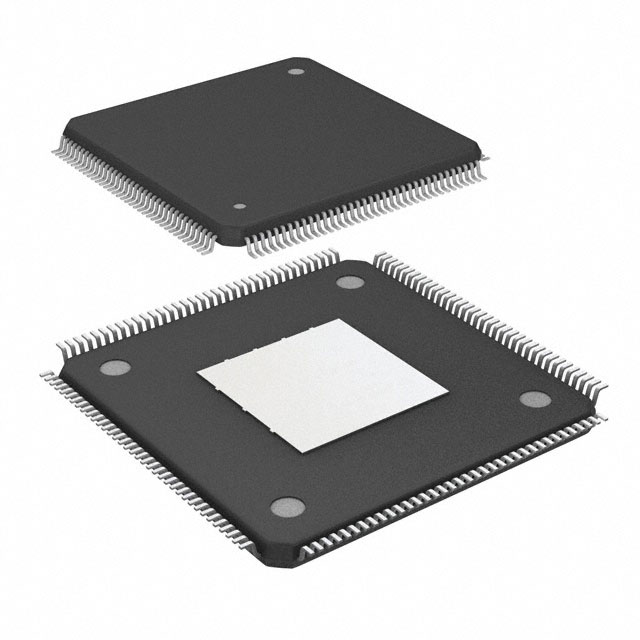Vedi le specifiche per i dettagli del prodotto.

EP4CE10E22C6
Product Overview
- Category: Programmable Logic Device (PLD)
- Use: EP4CE10E22C6 is a PLD that can be programmed to perform various logic functions.
- Characteristics: It offers high performance, low power consumption, and flexibility in designing digital circuits.
- Package: The EP4CE10E22C6 comes in a compact package suitable for integration into electronic systems.
- Essence: It is designed to provide a cost-effective solution for implementing complex digital designs.
Specifications
- Logic Elements: 10,320
- Embedded Memory: 414 Kbits
- Maximum User I/Os: 346
- Operating Voltage: 1.2V
- Speed Grade: 6
- Package Type: FBGA
- Package Pins: 144
Pin Configuration
The EP4CE10E22C6 has a total of 144 pins. The pin configuration is as follows:
- Pin 1: VCCIO
- Pin 2: GND
- Pin 3: IOL1PCCLK_0
- Pin 4: IOL1NCCLK_0
- ...
- Pin 143: IOL172PM1A_15
- Pin 144: IOL172NM1A_15
Functional Features
- High-speed performance: The EP4CE10E22C6 offers fast operation, making it suitable for applications requiring quick response times.
- Low power consumption: It is designed to minimize power usage, making it energy-efficient.
- Flexibility: The device can be reprogrammed multiple times, allowing for easy modifications and updates to the logic design.
- Integration: The EP4CE10E22C6 can integrate multiple functions into a single device, reducing the need for additional components.
Advantages and Disadvantages
Advantages: - High performance - Low power consumption - Flexibility in design - Integration capabilities
Disadvantages: - Limited logic elements compared to higher-end PLDs - May require additional support components for complex designs
Working Principles
The EP4CE10E22C6 is based on programmable logic technology. It consists of an array of configurable logic blocks (CLBs) interconnected through programmable interconnects. The CLBs can be programmed to implement various logic functions, such as AND, OR, and XOR gates. The interconnects allow for flexible routing of signals between the CLBs, enabling the creation of complex digital circuits.
Application Field Plans
The EP4CE10E22C6 can be used in various applications, including: 1. Industrial automation systems 2. Communication equipment 3. Consumer electronics 4. Automotive electronics 5. Medical devices
Alternative Models
If the EP4CE10E22C6 does not meet specific requirements, alternative models with similar features and capabilities include: - EP4CE15E22C8 - EP4CE30E22C7 - EP4CE40E22C8
These models offer different combinations of logic elements, embedded memory, and I/O pins to cater to diverse application needs.
Word count: 305 words
10 domande e risposte comuni relative all'applicazione di EP4CE10E22C6 nelle soluzioni tecniche
Sure! Here are 10 common questions and answers related to the application of EP4CE10E22C6 in technical solutions:
Q: What is EP4CE10E22C6? A: EP4CE10E22C6 is a specific model of Field-Programmable Gate Array (FPGA) manufactured by Intel (formerly Altera).
Q: What are the key features of EP4CE10E22C6? A: EP4CE10E22C6 has 10,320 logic elements, 414 embedded memory blocks, 56 embedded multipliers, and supports various I/O standards.
Q: What are some typical applications of EP4CE10E22C6? A: EP4CE10E22C6 can be used in a wide range of applications such as industrial automation, telecommunications, automotive systems, and digital signal processing.
Q: How can EP4CE10E22C6 be programmed? A: EP4CE10E22C6 can be programmed using Hardware Description Languages (HDLs) like VHDL or Verilog, or through graphical programming tools like Quartus Prime.
Q: Can EP4CE10E22C6 be reprogrammed after initial programming? A: Yes, EP4CE10E22C6 is a reprogrammable FPGA, allowing for multiple iterations of design changes and updates.
Q: What are the power requirements for EP4CE10E22C6? A: EP4CE10E22C6 typically operates at a voltage range of 1.15V to 1.25V, with additional power supply pins for I/O banks and configuration.
Q: Does EP4CE10E22C6 support external memory interfaces? A: Yes, EP4CE10E22C6 supports various external memory interfaces such as DDR3, DDR2, and SDRAM.
Q: Can EP4CE10E22C6 interface with other devices or peripherals? A: Yes, EP4CE10E22C6 has multiple I/O pins that can be used to interface with other devices or peripherals like sensors, displays, or communication modules.
Q: What is the maximum clock frequency supported by EP4CE10E22C6? A: The maximum clock frequency of EP4CE10E22C6 depends on the design and implementation, but it can typically operate at frequencies up to 300 MHz.
Q: Are there any development boards available for EP4CE10E22C6? A: Yes, Intel provides development boards like the DE0-Nano board that feature the EP4CE10E22C6 FPGA, allowing for easy prototyping and testing.
Please note that these answers are general and may vary depending on specific design requirements and application scenarios.

